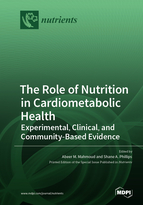The Role of Nutrition in Cardiometabolic Health: Experimental, Clinical, and Community-Based Evidence
A special issue of Nutrients (ISSN 2072-6643). This special issue belongs to the section "Nutritional Epidemiology".
Deadline for manuscript submissions: closed (30 November 2020) | Viewed by 56723
Special Issue Editors
Interests: cardiovascular disease; obesity; diabetes; metabolic disease; vascular biology; exercise physiology; molecular biology; pathology; nutrition; epigenetics; translational research; dietary interventions; biomarkers; chemoprevention; cancer biology; racial disparity; clinical trials
Special Issues, Collections and Topics in MDPI journals
Interests: vascular biology; clinical trials; exercise physiology; physical therapy; obesity; racial disparity; cardiovascular research; dietary interventions; translational research
Special Issues, Collections and Topics in MDPI journals
Special Issue Information
Dear Colleagues,
The purpose of this Special Issue “The Role of Nutrition in Cardiometabolic Health: Experimental, Clinical, and Community-Based Evidence” is to publish a focused, coherent, impactful, and well-cited volume on how nutrition influences diverse cardiometabolic risk factors. Cardiometabolic diseases, such as coronary heart disease, stroke, type 2 diabetes mellitus, and obesity, is the leading cause of death worldwide. In recent years, dietary habits have shifted all over the globe. At the same time, a constantly growing body of evidence demonstrates the role of caloric intake and dietary composition as determinants of cardiometabolic health. Suboptimal diet predisposes to a myriad of cardiometabolic risk factors such as impaired glucose metabolism, insulin resistance, dyslipidaemias, and high blood pressure. The goal of this Special Issue is to provide rigorous evidence from novel experimental and observational studies that support the association between dietary factors and cardiometabolic risk and evaluate the diverse diet-related risk pathways. Both original and review articles are acceptable. Articles of a basic science nature, animal studies, clinical/translational studies, epidemiological studies, meta-analyses, and behavioral studies are acceptable. Potential topics include, but are not limited to:
- effects of dietary patterns, nutrients (macro and micro), or supplements on vascular biology and/or physiology and endothelial health, inflammation and oxidative stress, glucose and insulin homeostasis, lipid and energy metabolism, blood pressure and cardiac function, metabolic expenditure and pathways of weight regulation, visceral adiposity and adipocyte metabolism, the gut microbiome, liver function and non-alcoholic steatohepatitis, coronary artery disease, atherosclerosis, and stroke;
- cellular, molecular, and epigenetic pathways that are modified by dietary factors and contribute to cardiometabolic health;
- genetic, environmental, and socioeconomic factors that affect dietary behavior and cardiometabolic outcomes;
- nutritional considerations for optimal cardiometabolic health;
- obesity and eating disorders in adults and children and how they modulate cardiometabolic risk;
- nutrition, physical activity, and bariatric surgery in relation to cardiometabolic health; and
- effects of plant-derived phytochemicals and bioactive compounds in cardiometabolic health.
Dr. Abeer M. Mahmoud
Prof. Shane Phillips
Guest Editors
Manuscript Submission Information
Manuscripts should be submitted online at www.mdpi.com by registering and logging in to this website. Once you are registered, click here to go to the submission form. Manuscripts can be submitted until the deadline. All submissions that pass pre-check are peer-reviewed. Accepted papers will be published continuously in the journal (as soon as accepted) and will be listed together on the special issue website. Research articles, review articles as well as short communications are invited. For planned papers, a title and short abstract (about 100 words) can be sent to the Editorial Office for announcement on this website.
Submitted manuscripts should not have been published previously, nor be under consideration for publication elsewhere (except conference proceedings papers). All manuscripts are thoroughly refereed through a single-blind peer-review process. A guide for authors and other relevant information for submission of manuscripts is available on the Instructions for Authors page. Nutrients is an international peer-reviewed open access semimonthly journal published by MDPI.
Please visit the Instructions for Authors page before submitting a manuscript. The Article Processing Charge (APC) for publication in this open access journal is 2900 CHF (Swiss Francs). Submitted papers should be well formatted and use good English. Authors may use MDPI's English editing service prior to publication or during author revisions.
Keywords
- diet
- risk factor
- nutrition
- supplements
- caloric restriction
- cardiometabolic
- obesity
- diabetes
- glucose metabolism
- insulin resistance
- lipid profile
- vascular biology
- endothelial function
- cardiovascular
- nutrigenomics
- epigenetics
- weight loss
- metabolism
- coronary artery disease
- stroke
- hypertension
- atherosclerosis
- inflammation
- oxidative stress
- phytochemicals
- bariatric surgery
- microbiome








